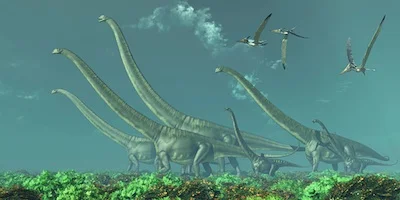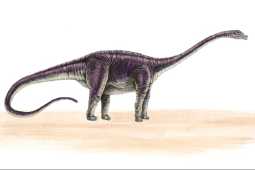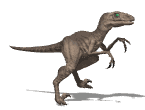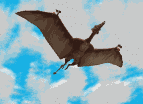Dinosaurs were reptiles that walked on the ground.
At the same time there were big reptiles that lived in the sea.
They breathed air and had flippers and sharp teeth.
At the same time, there were reptiles that could fly.
They could fly but did not walk well on the ground.
Some were huge and some were tiny.
Dinosaurs and other prehistoric reptiles lived on Earth about 230 million years ago.
There were NO humans in the time of the dinosaurs!
The Age of the Dinosaurs
About 230 million years ago, dinosaurs and other prehistoric reptiles lived on Earth.
Dinosaurs were prehistoric reptiles that lived on land. No dinosaurs could fly and none lived in the water. Dinosaurs dominated the Earth for 185 million years, before there were humans. This huge chunk of time is the Mesozoic era, often called the Age of the Dinosaurs, and is divided into three smaller periods of time: the Triassic, Jurassic and Cretaceous periods.
Dinosaurs were different from other prehistoric reptiles because of the way they stood and walked with their bodies off the ground. Their legs were underneath their bodies rather than sticking out from their sides like those of crocodiles and turtles today.
Dinosaurs
Dinosaurs were reptiles and most of them hatched from eggs. Some dinosaurs were as tall as a five-storey building, and there were others no bigger than a chicken. In between the largest and the smallest, there were dinosaurs of all shapes and sizes. As the Earth changed, dinosaurs lived in many different habitats, from open plains to forests to the edges of swamps, lakes, and oceans.
The dinosaurs had tough skin, some with scales or feathers. Some were armour-plated and covered with spikes. The name 'dinosaur' means 'terrible lizard'. However, dinosaurs were not lizards, although related to them. Many scientists think that dinosaurs were more closely related to birds.
A lizard-hipped dinosaur
Dinosaurs are classified into two groups
Lizard-hipped dinosaurs.
These were dominant in the Triassic and Jurassic periods.
A bird-hipped dinosaur
Bird-hipped dinosaurs.
These were dominant in the Cretaceous period.
Dinosaur diet
Diplodocus was a herbivore
Most dinosaurs were herbivores and ate plants. They had teeth designed to grind their food. They had larger intestines than carnivores because plants are harder to digest than meat, so they had to eat huge quantities. Their large heavy stomachs meant they had to walk on all fours most of the time so as not to overbalance.
The largest dinosaurs may have grown as long as 45 m and weighed as much as 77 tonnes. Later on, some herbivores developed that had stomachs between their hind legs, and these were able to move around on two legs. Iguanadon is one such herbivore.
Other herbivores developed armour plating and moved about on all fours, for example, stegosaurus, triceratops and dyoplosaurus.
Raptors were carnivores
Some dinosaurs were carnivores, which means they ate meat. They had sharp teeth and claws.
Tyrannosaurus rex, allosaurus and baryonyx were carnivores.
Other prehistoric reptiles
Dinosaurs were prehistoric reptiles that lived on land. No dinosaurs could fly and none lived in the water.
There were other prehistoric reptiles that lived in the water, called the plesiosaurs (say pless-ee-oh-saws). There were other prehistoric reptiles that flew, called the pterosaurs (say ter-ruh-saws). These reptiles were not dinosaurs, but lived at the same time.
Dinosaurs were different from other prehistoric reptiles because of the way they stood and walked with their bodies off the ground. Their legs were underneath their bodies rather than sticking out from their sides like those of crocodiles and turtles today.
Some prehistoric reptiles flew. They were called pterosaurs.
Pterosaurs lived at the same time as the dinosaurs but were not dinosaurs. 'Pterosaur' means 'flying lizard'.
Pterosaurs had large brains and fur-covered bodies. Some were the size of today's sparrows, while others were far larger. They had light, hollow bones, like those of birds.
Although they had similarities to today's birds and bats, scientists do not believe that pterosaurs are the ancestors of either.
Fossil of a pterosaur
Pterosaurs had hands. Three fingers were claws, but the long fourth finger was part of the wing. Thin leathery skin stretched from this to the foot to form a wing on either side. The wings were attached to the body and thigh. The wings had stiff fibres that were like the ribs of an umbrella. Scientists thought that pterosaurs were all gliders and did not flap their wings, but skeletons have been discovered with crests on the bones to which wing muscles would have been attached, which indicates they flew.
On land, pterosaurs probably crawled on all fours, like modern bats. They probably folded their wings back so that their fingers could grip the ground.
Scientists are not sure how pterosaurs launched into flight. Some think they were so clumsy on land that they possibly jumped off cliffs or trees to get airborne. Others believe that there were able to land and take off in similar fashion to birds of today.
Many pterosaur fossils and footprints have been found in areas next to seas or lakes, so they may have fed in similar fashion to today's water birds. Some had beaks similar to those of modern spoonbills or pelicans, or had strainer-like teeth to filter minute creatures from water. Some had long beaks which may have been used to plunge down into mud holes made by crustaceans.
Pterosaurs existed from the late Triassic period to the end of the Cretaceous period.
Watch a video about a Pterosaurs: flying dinosaurs
Prehistoric marine reptiles were called plesiosaurs.
Plesiosaurs swam by moving all four flippers. Image©Getty
Plesiosaurs were not dinosaurs, but large marine reptiles that lived in the seas during the Age of the Dinosaurs. They had four flippers and pointed tails. They paddled with all four flippers as they swam, rather like turtles do today.
Plesiosaurs lived in the oceans, but breathed air. They probably laid eggs on sandy beaches, like today's sea turtles. They had sharp teeth and ate fish and other marine creatures.
dolichorhynchops, a pliosaurid plesiosaur ©Getty Images
There were two kinds of plesiosaurs
plesiosaurids (it is confusing that the same word refers to the whole of the marine reptiles as well as one group of them)
pliosauroids.
Their bodies and behaviours were different.
The plesiosaurids had very long snake-like necks and tiny heads. They were not fast swimmers. Their diet was fish.
The pliosauroids were bigger, stronger and meaner, with big, sharp teeth. They had short necks. It appears that they probably fed on anything that came their way, from fish to other marine reptiles.
Dinosaurs and the prehistoric reptiles became extinct
Could a giant meteor have caused the extinction of the dinosaurs? ©Getty Images
It is believed that about 65 million years ago a huge meteor hit the earth, causing such enormous clouds of dust to block the sun's rays so that the earth became dark and cold for a number of years. Huge tidal waves flooded low-lying land and acid rain fell.
Small animals could find shelter and enough warmth and food, but the huge dinosaurs could not. Being reptiles, they needed the sun to warm them. They died out.
However, dinosaurs had been extremely successful land animals, having existed for about 185 million years, dominating the earth. They were not able to adapt when huge changes happened to the Earth, and so became extinct.
It’s a good idea to find information from more than one source!
The world was very different in the Age of the Dinosaurs. Read about it and how it changed during the time dinosaurs ruled the earth
Watch a video telling us 10 facts about dinosaurs
https://www.youtube.com/watch?v=8L2K-zVQ-uo
Read about bird-hipped and lizard-hipped dinosaur groups:
http://www.fossils-facts-and-finds.com/dinosaur_classification.html
Read about prehistoric flying reptiles
https://www.kids-dinosaurs.com/flying-dinosaurs.html
Read about prehistoric swimming reptiles
https://www.kids-dinosaurs.com/swimming-dinosaurs.html













